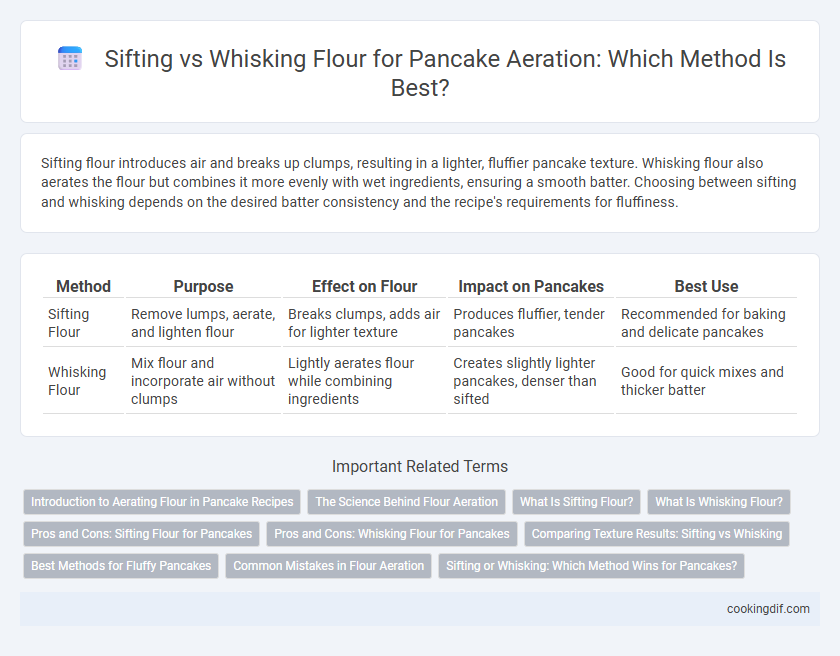Sifting flour introduces air and breaks up clumps, resulting in a lighter, fluffier pancake texture. Whisking flour also aerates the flour but combines it more evenly with wet ingredients, ensuring a smooth batter. Choosing between sifting and whisking depends on the desired batter consistency and the recipe's requirements for fluffiness.
Table of Comparison
| Method | Purpose | Effect on Flour | Impact on Pancakes | Best Use |
|---|---|---|---|---|
| Sifting Flour | Remove lumps, aerate, and lighten flour | Breaks clumps, adds air for lighter texture | Produces fluffier, tender pancakes | Recommended for baking and delicate pancakes |
| Whisking Flour | Mix flour and incorporate air without clumps | Lightly aerates flour while combining ingredients | Creates slightly lighter pancakes, denser than sifted | Good for quick mixes and thicker batter |
Introduction to Aerating Flour in Pancake Recipes
Aerating flour in pancake recipes improves texture and fluffiness, with sifting and whisking being common methods. Sifting flour introduces air by passing it through a fine mesh, breaking up clumps and lightening the flour consistency. Whisking flour vigorously also incorporates air while blending, making it a faster alternative that enhances batter aeration for tender pancakes.
The Science Behind Flour Aeration
Flour aeration enhances pancake texture by incorporating air, which affects gluten development and batter lightness. Sifting flour breaks up clumps and introduces fine air pockets, promoting more even hydration and fluffier pancakes. Whisking flour also aerates by rapidly mixing air into the dry ingredient, creating a lighter batter consistency that results in tender, airy pancakes.
What Is Sifting Flour?
Sifting flour involves passing it through a fine mesh sieve to break up clumps and incorporate air, resulting in a lighter and more uniform texture for pancakes. This process enhances the flour's ability to blend smoothly with wet ingredients, improving the batter's consistency and fluffiness. Compared to whisking, sifting provides a finer aeration that can produce more tender and evenly risen pancakes.
What Is Whisking Flour?
Whisking flour is a technique used to aerate and evenly distribute the flour's particles without the need for a sifter, making it ideal for pancakes and other quick breads. This process involves vigorously stirring the flour with a wire whisk to break up lumps and incorporate air, resulting in a lighter, fluffier texture in the batter. Unlike sifting, whisking can be done directly in the mixing bowl, saving time while still enhancing the final pancake quality.
Pros and Cons: Sifting Flour for Pancakes
Sifting flour for pancakes improves aeration by breaking up clumps and incorporating air, resulting in lighter, fluffier pancakes with a finer texture. It also ensures even distribution of ingredients like baking powder, preventing uneven rising. However, sifting can be time-consuming and may lead to slight flour loss, making whisking a quicker alternative that still blends ingredients but may not achieve the same level of aeration.
Pros and Cons: Whisking Flour for Pancakes
Whisking flour for pancakes helps to incorporate air quickly, resulting in a lighter, fluffier batter with improved texture. It is less time-consuming than sifting and can evenly break up clumps, but may not aerate the flour as thoroughly as sifting. However, whisking may leave some larger flour particles, potentially affecting the smoothness of the pancake batter compared to the fine aeration achieved by sifting.
Comparing Texture Results: Sifting vs Whisking
Sifting flour aerates by breaking up clumps and ensuring finer particles, resulting in pancakes with a lighter, fluffier texture and more even rise. Whisking flour incorporates air more quickly through vigorous movement, producing a slightly denser crumb but with well-distributed air pockets that enhance tenderness. Comparing texture results, sifting yields consistently delicate pancakes while whisking offers a quicker method to achieve similar aeration, affecting the final texture subtly but effectively.
Best Methods for Fluffy Pancakes
Sifting flour for pancakes helps remove clumps and aerates the flour, resulting in a lighter batter that promotes fluffy texture. Whisking flour with other dry ingredients also incorporates air, but sifting provides a more consistent aeration and even distribution. For the best fluffy pancakes, sifting flour before mixing with wet ingredients is recommended to maximize air incorporation and ensure tender, airy pancakes.
Common Mistakes in Flour Aeration
Sifting flour is often mistaken as the only method for aerating flour, but whisking can be equally effective in incorporating air and breaking up clumps. Common mistakes include over-sifting, which can lead to a denser batter, and under-whisking, resulting in uneven flour distribution and lumpy pancakes. Proper aeration techniques ensure a lighter, fluffier texture for pancakes by optimizing the flour's ability to trap air during mixing.
Sifting or Whisking: Which Method Wins for Pancakes?
Sifting flour removes lumps and incorporates air, resulting in lighter, fluffier pancakes, while whisking effectively aerates the flour by breaking up clumps and mixing it with other dry ingredients. Pancake recipes often benefit from whisking because it combines aeration with even ingredient distribution, enhancing batter consistency without the need for extra tools. For optimal pancake texture, whisking flour is faster and equally effective compared to sifting, especially in home kitchens.
Sifting flour vs whisking flour for aeration Infographic

 cookingdif.com
cookingdif.com